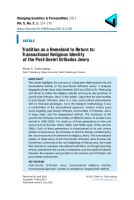Tradition as a Homeland to Return to: Transnational Religious Identity of the Post-Soviet Orthodox Jewry
Author(s)
Publication Name
Publication Date
Abstract
This article highlights the outcome of a long-term field research into the transnational identity of the post-Soviet Orthodox Jewry. It analyzes biographical interviews taken between 2015 and 2018 in St. Petersburg and Minsk to define the religious identity and day-to-day practices of post-Soviet Orthodox Jews. In this article, I argue that the modern post-Soviet Jewry is a new socio-cultural phenomenon with no historical prototypes. As to the research methodology, it was a combination of the transnational approach, random choice case-study targeting post-Soviet Orthodox communities of Orthodox Jewry in large cities, and the biographical method. The backbone of the post-Soviet Orthodox communities of different strains of Judaism was formed in 1990–2008. It is made up of three generations of men and women born in the late 1940s–1960s, mid-1960s–early 1970s, and the 1980s. Each of these generations is characterized by its own unique pattern of observance, the formation of which is directly conditioned by the circumstances of involvement in religious Jewry. The transnational pattern of observance of the Post-Soviet Orthodox Jews involves the model they confronted at the very beginning of their journey, the model they learned in overseas educational institutions or through incoming envoys and rabbis in the country of residence, and the model of balance between the required and possible in the modern post-Christian and post-atheist environment.
Topics
Jewish Identity Main Topic: Identity and Community Orthodox Judaism Religious Observance and Practice
Genre
Geographic Coverage
Original Language
Volume/Issue
5(2)
Page Number / Article Number
201–219
DOI
Link
Link to article including link to pdf, Tradition as a Homeland to Return to: Transnational Religious Identity of the Post-Soviet Orthodox Jewry
Bibliographic Information
Tradition as a Homeland to Return to: Transnational Religious Identity of the Post-Soviet Orthodox Jewry. 2021: 201–219. https://archive.jpr.org.uk/10.15826/csp.2021.5.2.129




